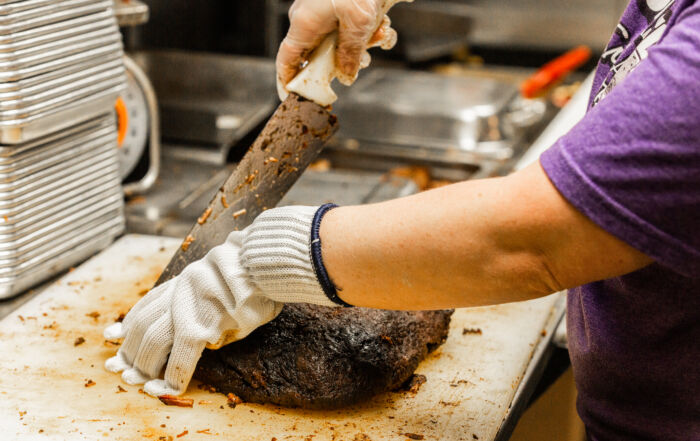Put the Gloves On!
When you hear “Put the Gloves On” you typically think that a fight is about to ensue. Well, in foodservice that is exactly what gloves do—put up a fight against contamination! Gloves provide an extra measure of prevention for foodborne illness when used correctly. So, in this month’s blogs, we will talk about gloves and how they can be used in your operation to “fight for food safety”!
The FDA Food Code, upon which local food codes are based, requires that gloves be used when handling any ready-to-eat (RTE) foods. RTE foods are those that do not have a heat treatment that can kill bacteria—such as raw fruits and vegetables, bakery items, deli meats, and cheeses, to name a few. Gloves can be used when handling other foods, too, depending on preferences of employees. Why are gloves required for RTE foods? Because gloves provide a barrier between hands and food, they are an extra layer of protection for those foods that are eaten without cooking.
But just putting on gloves isn’t the entire defense strategy. Research from the Centers for Disease Control and Prevention indicates that two of the top four contributing factors for foodborne illness outbreaks are workers contaminating RTE foods with bare-hand contact and contaminating RTE food through gloved-hand contact. Not wearing gloves is a problem, but wearing contaminated gloves can also affect the safety of the food served.
Use Gloves Correctly
Gloves are only effective if they are used correctly. Hands must be thoroughly washed prior to donning gloves because dirty hands will contaminate the gloves when putting them on. Gloves must be changed between tasks to avoid cross contamination. Employees can’t make sandwiches, take money, and then make another sandwich wearing the same gloves! In this case, the employee must wash hands, put on gloves, and make the sandwich. The gloves should be removed before taking money from a customer. After the transaction, the sequence must be repeated—wash, put on a new pair of gloves, make the sandwich. Sometimes workers are busy or lazy and just move from task to task, or simply change gloves without handwashing. Managers should coach staff on working as a team and assigning responsibilities to avoid interruptions in work. For instance, one worker should make sandwiches and another handle the sales transactions.
Foodservice gloves are designed to be single use. That means they must be changed when they are damaged, soiled, or when interruptions occur in a task. For example, a worker making those deli sandwiches in an assembly line process runs out of cheese, and rushes to the walk-in to get more cheese. In this case, hands should be washed and gloves changed after retrieving the cheese because there are many possibilities for cross contamination. Think about how many people have touched that refrigerator handle in any given hour! A better strategy is to plan ahead for supplies needed or ask a co-worker to provide the needed item. (That person could also take the completed tray of sandwiches to the cooler for holding before service).
The 2017 Food Code addresses the use of gloves when a worker has a cut or burn. If bandages, finger cots, or finger stalls are used on the wrist, hand, or finger, a food worker shall cover it with a single-use glove. Again, an added layer of protection for the food being prepared. No food operation wants a photo of a bandaid in one of their salads going viral!
Put on Gloves
Here are the steps for putting on gloves properly:
- Wash hands using good technique (Go to the FoodHandler.com website for posters on handwashing)
- Select the proper size of glove
- Pull a glove out of the box one at a time
- Handle only the cuff of the glove
FoodHandler has wall mounted, table top, and boxes that will self-dispense gloves to minimize the risk of contamination. You may want to check out OneSafe® dispensers for your operation—they are convenient and can save money in the long run because they dispense only one glove at a time so gloves are not contaminated or wasted.
Change Gloves as Needed
Managers and staff need to keep stressing the need to change gloves to minimize cross contamination. Here are times when workers should change gloves:
- Before handling a different type of food
- After touching anything that could contaminate hands
- After coughing or sneezing
- When gloves are ripped or torn
- At least every four hours when working on the same task.
Summary
It can get confusing in a hectic foodservice operation remembering all of these defense strategies. Basically there are DO’s and DON’Ts to remember. FoodHandler® has signage to remind workers of best practices as a way of keeping the fight ongoing. Here is a list of things that you should DO when using gloves:
- Wear gloves for handing ready-to-eat foods—ALWAYS!
- Wash hands before putting on gloves
- Select the proper size of gloves
- Select the appropriate type of glove
- Change gloves between tasks
- Change glove if there is a rip or tear
- Wear gloves over bandages, finger cots, or finger stalls
- Store glove boxes where they can’t become easily contaminated
Along with what you should do, there is a list of what you DO NOT DO:
- Blow into gloves to make them easier to put on
- Handle gloves except by the cuff
- Put gloves back into the box if extras come out
- Use gloves that have dropped onto the countertop or floor
- Place glove boxes so that they can easily fall
Now, the fight is on! Gloves are an important part of your strategy for fighting foodborne illness in your operation—after all, we want a TKO for pathogens. None of those little jabs, we want a knockout! Risk Nothing!

READ MORE POSTS
The Second Wave: Food Safety Myths That Deserve Your Attention
Walk into any commercial kitchen, and you'll find hardworking staff following protocols they have learned [...]
What Your Staff Gets Wrong About Food Safety (And How to Fix It)
Earlier this month, I was mindlessly scrolling through Facebook when I came across a post [...]
Your Guide to Approved Food Safety Training Programs in 2025
Early in my foodservice career, I persuaded the owners of the restaurants I managed to [...]
Thanksgiving Food Safety: Separating Fact from Fiction
Most blogs that I write are geared toward the foodservice professional preparing food in commercial [...]










